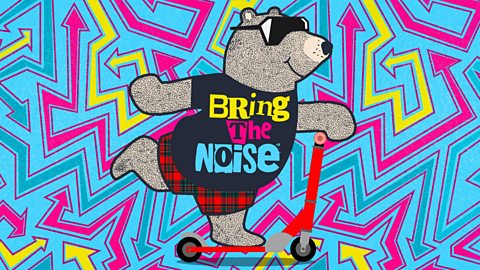A first for CBeebies Bedtime Stories
They've been part of parenting for thousands of years, singing a lullaby to get a baby or small child to sleep is a tradition that spans countries and cultures.
On Friday 22 November, soul icon Gregory Porter is singing the first ever CBeebies bedtime lullaby with a soothing version of Moon River.
The oldest lullaby on record, from Babylonia, was called Little baby in the dark house, and is 4,000 years old.
Research has shown hearing music and singing out loud is linked to evoking a calming state, improving well-being and extending language acquisition in children.
Angeline Conaghan, is co-director of Groundswell Arts, their project Sing Our Story is a lullaby song writing initiative, working with parents and early year practitioners to compose lullabies and bespoke songs for their children.
She said the benefits for parents and carers of singing to their child is "it reduces your stress levels" as "what is good for the child is usually good for the adult too."
Watch Gregory Porter talk about why lullabies are so special
Gregory Porter:
Wow the beauty of a lullaby, I love lullabies and I like the children's lullabies, I love grown man lullabies. Um…, the idea of soothing and easing the ear and the mind and eyes and body with music is, is somethin' that amazin' to me, and somethin' that is central in singin' a lullaby. It's a uh…, it's a nighttime song, it's a sleepy song and it ha…, and it…, and it exists in everyculture, in Mexico, in Africa and Russia they have these songs to soothe and comfort the young ones and the old ones. So it's an amazing thing and it's a human thing, so I love lullabies.
The ingredients of a lullaby
Lullabies are often simple with a repeating melody and lyrics, giving a circular structure rather than a ‘verse, chorus’ structure like a pop song would have.
Melodies are often a combination of sweet notes and soft sounds to create sleepy songs, with the repetition making it easy to remember for the adult and helping to improve a child's language development as they hear the same sounds, so building familiarity.
Although content differs from lullaby to lullaby, there is often an underlying theme of love, care and tenderness.
A lullaby can also be a great way to give parents their voice and reflect inner feelings as they talk about knowledge and experiences they want to pass on.
The slow tempo allows words to be lengthened, helping little ones wind down.
Listen to find out more about lullabies, featuring Angeline Conaghan.
Creating your own lullaby
A lot of lullabies have a swinging feel to them, perfect for rocking a baby to sleep. This is achieved with a 6/8 time signature.
To try to get a feel for how this works, start by counting with a steady pace from one to four, clapping each time you say ‘one’.
This is 4/4 time which is common to all sorts of western music.
Now, try counting from one to six in the same way, clapping on ‘one’ and ‘three’. That swingy rhythm is 6/8. For a real-world example of a lullaby in 6/8, listen to the classic ‘Rock-a-Bye Baby’.
Now taking the foundations, let’s see if you can cook up your own lullaby?
Angeline proposes a helpful tip if you find you are struggling to come up with a tune, using the opening of The Beatles song Hey Jude and the song's interval between the words 'Hey' and 'Jude' which “is very universal across many languages.”
Repeating those two notes around 'Hey' and 'Jude', you have a recognisable melody which can help you start off your lullaby or even become the overall melody.
Another idea is to use the Bring the Noise song Take You 91»»±¨ which is an excellent, relaxing melody to springboard from.
Sprinkle in the lyrics and make it about them
It's helpful when creating a lullaby for children to involve personalised information as well.
For children hearing “their own name, hearing names of places and people that they recognise and things that are special and unique to them, has an extra added benefit," Angeline, said
"We’ve found it makes a real long term difference to children and to families as well."
You could not worry about words and "by hearing your babies sounds and babbling" you can use the noises they make to compose a song and "so even the sounds the child makes, could become a piece of music", Angeline suggested.
Don’t feel pressure to come up with poetic, genius rhymes, just see what comes out.
You could even get inspiration from this episode of Thunder Jam where school children write about their school day.

Mix in the benefits
Singing to your child is a way of giving each other company; it helps put you both in the same calm mood whilst promoting learning.
By singing to them in your own voice, at a familiar time with a personal song, you will help establish a routine and make sleep time an easier task to regulate.
Singing to your child is an important device to connect and develop them.
Your voice is probably the first thing they will hear inside and outside the womb, and it will tune them in to the outside world.
You don’t need to stop singing lullabies once a child gets older either – lullabies as part of a routine, and to connect, can be valuable to children as old as four or five-years-old.
Creating lullabies can be a great way to explain the changes in the world a child experiences.
"Children respond to that personal life experience more than anything else," Angeline explained.
Parents could share their thoughts and experiences, singing what they want to say to their children.
It is also a great way to learn about different cultures and traditions by sharing your homemade lullabies with other parents in the community.
By generating your own lullabies, you could help create a legacy which can then be passed on for another 4000 years.
Groundswell Arts Sing Our Story project is funded by Youth Music (one of our Bring the Noise partners). For more information about running inclusive early years music-making sessions, visit the .

More from Bring the Noise
Five tips on teaching music for beginners
How to get started if you don't play an instrument or feel you can sing.

Children's song lyrics and downloads
Song lyrics, downloads, lesson plans and resources for use with Bring the Noise songs.
